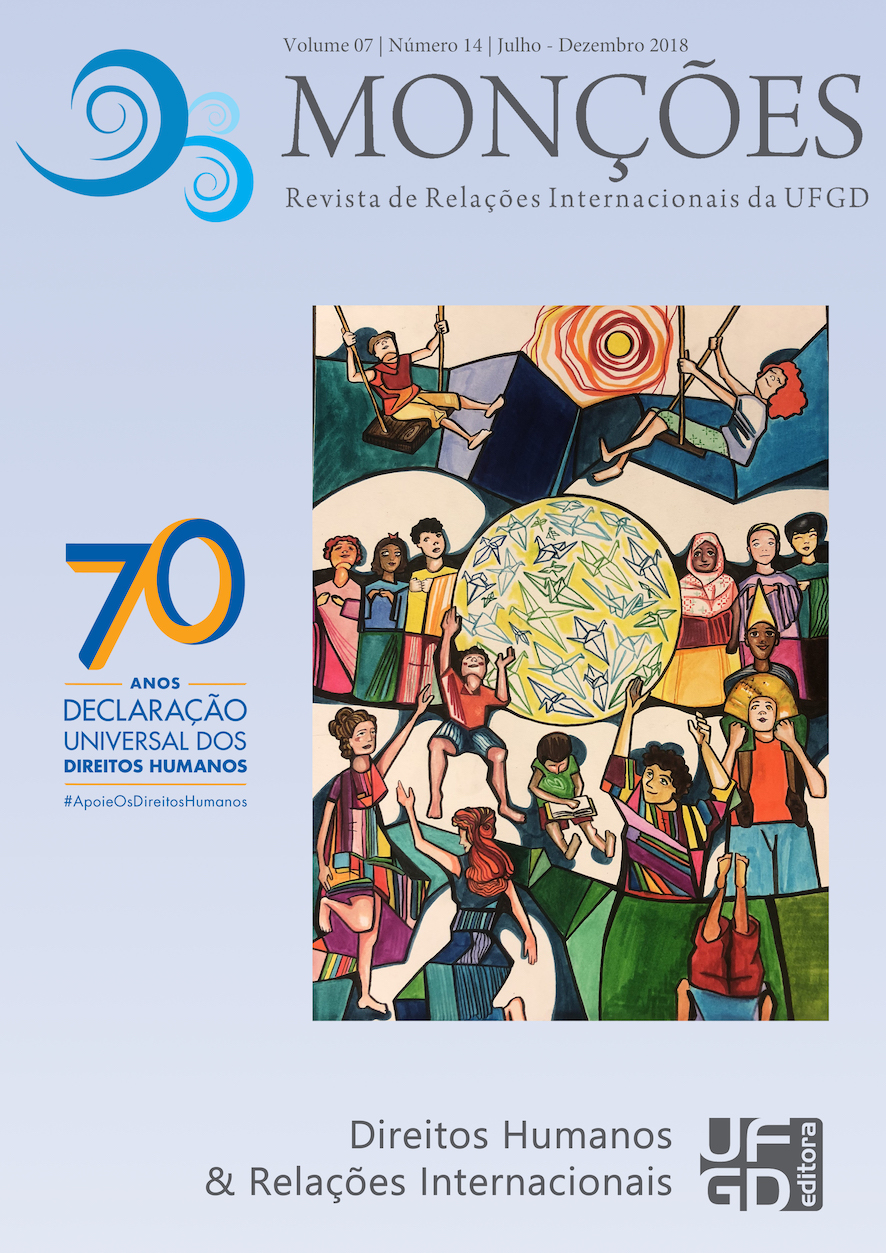Brazil and the future of the international mobility regime
DOI:
https://doi.org/10.30612/rmufgd.v7i14.9132Keywords:
Brazil. Model International Mobility Convention. Migration. Refugees.Abstract
To celebrate the current issue on the 70th anniversary of the Universal Declaration of Human Rights, our paper aims to briefly introduce how the United Nations (UN) is currently dealing with international mobility. We further discuss how Brazil has advanced the migrant and refugee agenda. Finally, we discuss the Model International Mobility Convention (MIMC) and how can it contribute to Brazil’s aspirations on international mobility.Downloads
References
BRAZIL, Secretaria Nacional de Justiça, “Refúgio em Números – 3ª Edição”, (2018), http://dados.gov.br/dataset/comite-nacional-para-os-refugiados Last visited on September 03, 2018.
DOYLE, Michael W.. Model International Mobility Convention. Columbia Journal of Transnational Law, Vol.56m No. 2, p.220, 2018.
GUZMAN, Andrew. A Compliance Based Theory of International Law, 90 California Law Review, p. 1826-1888, 2002.
INTERNATIONAL ORGANIZATION FOR MIGRATION (IOM), Migration Data Portal, 2017, https://migrationdataportal.org/?i=stock_abs_&t=2017&cm49=76&m=2&sm49=5 Last visited on September 03, 2018.
JUBILUT, L.L. Enhancing Refugees’ Integration: New Initiatives in Brazil, Forced Migration Review, 35, 46–47, 2010.
KEOHANE, Robert. Reciprocity in International Relations, International Organization, v. 40, No. 1, pp. 1-27, 1986.
KOSLOWSKI, Rey. Conclusions: Prospects for Cooperation, Regime Formation, and Future Research. Global Mobility Regimes, (Koslowski ed.), 260–61, 2011.
LONG, Katy & ROSENGERTNER, Sarah. Migration Pol’y Inst., Protection through Mobility: Opening Labor and Study Migration Channels to Refugees, 2016, http://www.migrationpolicy.org/research/protection- through-mobility-opening-labor-and-study-migration-channels-refugees [https://perma.cc/BP3M-X5UZ ] Last visited on May 03, 2018.
MASSEY, Douglas S. Theories of International Migration: A Review and Appraisal, 21 POPULATION & DEV. REV. 631, 1995.
MOREIRA, Julia B. & BAENINGER, Rosana. Local Integration of Refugees in Brazil, Forced Migration Review, 35, 48–49, 2010.
MOREIRA, Julia B. Refugee Policy in Brazil (1995-2010): Achievements and Challenges. Refugee Survey Quarterly, v. 36, p.25, 2017.
OKOTH-OBBO, G., O´CONNOR, C.M., KJAERUM, M. & CHANTAVANICH, S., “Regional Approaches to Forced Migration”, in J. Van Selm, K. Kamanga, A. Nadi, S. Spoljar-Vrzina & L. Van Willigen (eds.), The Refugee Convention at Fifty: a View from Forced Migration Studies, Lanham/Oxford, Lexington Books, 31–45, 2003.
OLIVEIRA, Antônio Tadeu Ribeiro de. Nova lei brasileira de migração: avanços, desafios e ameaças. Revista Brasileira de Estudos de Populacao, vol.34, n.1, pp.171-179, 2017.
SALLES, M.R.R., “Panorama da Imigracão para São Paulo no pós-Segunda Guerra Mundial: os ‘Deslocados de Guerra” Studi Emigrazione, XLI (155), 554–574, 2004.
SENGUPTA, Somini. Climate Change Is Driving People From Home. So Why Don’t They Count as Refugees?, N.Y. TIMES (Dec. 21, 2017), https://www.nytimes.com/2017/12/21/climate/climate-refugees.html [https://perma.cc/8DMN-NKVM]. Last visited on March 11, 2018.
STEFONI, Carolina. Panorama de la migración internacional en América del Sur, Serie Población y Desarrollo, No. 123, Comisión Económica para América Latina y el Caribe (CEPAL), pp.54, 2018.
TSABUTASHVILI, Dato., Number of Potential Migrants Worldwide Tops 700 Million, GALLUP NEWS, http://www.gallup.com/poll/211883/number-potential-migrants-worldwide-tops-700-million.esps7version-print [https://perma.cc/9CAY-MN7Z]. Last visited on June 8, 2017.
UNITED NATIONS CONVENTION AND PROTOCOL RELATIONG TO THE STATUS OF REFUGEES, art. IA(2), July 28, 1951, U.S.T. 6259, 189 U.N.T.S. 137, http://www.unhcr.org/en-us/3b66c2aa10 Last visited on September 01, 2018.
UNITED NATIONS GLOBAL MIGRATION DATABASE (UNGMD), Migration Data Portal, 2017, https://esa.un.org/unmigration/ Last visited on September 01, 2018.
UNITED NATIONS HIGH-COMMISSIONER FOR REFUGEES (UNHCR), Global Trends 2017, available at https://www.unhcr.org/statistics/unhcrstats/5b27be547/unhcr-global-trends-2017.html Last visited on September 03, 2018.
UNITED NATIONS HIGH-COMMISSIONER FOR REFUGEES (UNHCR), Guterres Praises Brazilian Efforts to Integrate Refugees, UNHCR News, 2005, available at: http://www.unhcr.org/news/latest/2005/11/43722e6a2/guterres-praises-brazilian-efforts-integrate-refugees.html Last visited September 11, 2018
UNITED NATIONS Special Representative of the Secretary-General for Migration, Report of the Special Representative of the Secretary-General for Migration, 64–65, U.N. Doc A/71/728, 2017.
WORLD BANK GROUP, Migration and Development: A Role for the World Bank Group (2016), http://pubdocs.worldbank.org/en/468881473870347506/Migration-and-Development-Report-Sept2016.pdf [https://perma.cc/9VP5-BQV8]. Last visited on September 03, 2018.
Downloads
Published
How to Cite
Issue
Section
License
- Os autores e autoras mantêm os direitos autorais e concedem à revista o direito de primeira publicação, com o trabalho simultaneamente licenciado sob a Creative Commons Atribuição-NãoComercial-CompartilhaIgual 3.0 Brasil. que permite o compartilhamento do trabalho com reconhecimento da autoria e publicação inicial nesta revista.
- Autores e autoras têm autorização para assumir contratos adicionais separadamente, para distribuição não-exclusiva da versão do trabalho publicada nesta revista (ex.: publicar em repositório institucional ou como capítulo de livro), com reconhecimento de autoria e publicação inicial nesta revista.
- Autores e autoras têm permissão e são estimulados a publicar e distribuir seu trabalho online (ex.: em repositórios institucionais ou na sua página pessoal) a qualquer ponto antes ou durante o processo editorial, já que isso pode gerar alterações produtivas, bem como aumentar o impacto e a citação do trabalho publicado, porém invariavelmente com o reconhecimento de autoria e publicação inicial nesta revista.


